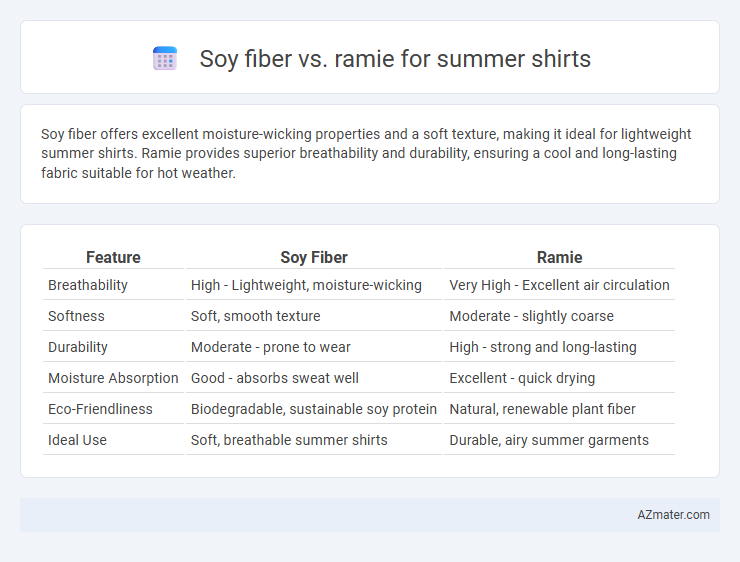Soy fiber offers excellent moisture-wicking properties and a soft texture, making it ideal for lightweight summer shirts. Ramie provides superior breathability and durability, ensuring a cool and long-lasting fabric suitable for hot weather.
Table of Comparison
| Feature | Soy Fiber | Ramie |
|---|---|---|
| Breathability | High - Lightweight, moisture-wicking | Very High - Excellent air circulation |
| Softness | Soft, smooth texture | Moderate - slightly coarse |
| Durability | Moderate - prone to wear | High - strong and long-lasting |
| Moisture Absorption | Good - absorbs sweat well | Excellent - quick drying |
| Eco-Friendliness | Biodegradable, sustainable soy protein | Natural, renewable plant fiber |
| Ideal Use | Soft, breathable summer shirts | Durable, airy summer garments |
Introduction to Plant-Based Fibers for Summer Apparel
Soy fiber, derived from soybean proteins, offers a soft, breathable, and moisture-wicking fabric ideal for summer shirts, promoting comfort and sustainability. Ramie, a bast fiber extracted from the stalks of the Ramie plant, provides high strength, durability, and excellent breathability, making it suitable for lightweight summer clothing. Both fibers are plant-based, biodegradable, and environmentally friendly, enhancing their appeal in eco-conscious summer apparel collections.
What Is Soy Fiber?
Soy fiber, also known as vegetable cashmere, is a sustainable fabric made from soybean protein residue left after oil extraction, offering a soft, breathable, and moisture-wicking material ideal for summer shirts. Unlike ramie, which is derived from a flowering plant and known for its durability and silk-like luster, soy fiber provides exceptional comfort and hypoallergenic properties, making it suitable for sensitive skin. Its lightweight and eco-friendly attributes contribute to temperature regulation and enhanced wearer comfort during hot weather.
Understanding Ramie Fiber
Ramie fiber, derived from the stalks of the Chinese nettle plant, boasts exceptional breathability and moisture-wicking properties ideal for summer shirts. Its natural resistance to mold and mildew, combined with a lustrous sheen and durability, makes ramie a superior choice for hot and humid climates. Compared to soy fiber, which is softer but less durable, ramie ensures longer-lasting garments that maintain shape and comfort in warm weather.
Breathability and Moisture Management
Soy fiber offers excellent breathability and moisture-wicking properties, making it ideal for summer shirts by keeping the wearer cool and dry. Ramie fabric, derived from a natural bast fiber, also provides good air permeability but tends to retain more moisture, which can affect comfort during intense heat. Overall, soy fiber outperforms ramie in moisture management, enhancing wearer comfort in hot, humid conditions.
Comfort and Skin Friendliness
Soy fiber offers exceptional softness and moisture-wicking properties, making it ideal for summer shirts by enhancing comfort and breathability. Ramie fabric is highly durable and absorbent but can feel slightly coarse, which might affect comfort for sensitive skin. Choosing soy fiber ensures a softer, more skin-friendly experience, while ramie provides strength and natural antibacterial benefits.
Durability and Longevity
Ramie fiber offers superior durability and resistance to wear compared to soy fiber, making it ideal for long-lasting summer shirts subjected to frequent washing and sun exposure. Soy fiber provides a soft, breathable feel but tends to have lower tensile strength, leading to quicker fabric degradation over time. Choosing ramie ensures enhanced garment longevity and maintains structural integrity even in hot, humid conditions.
Environmental Impact and Sustainability
Soy fiber and ramie are both sustainable fabric choices for summer shirts, with soy fiber being biodegradable and derived from renewable soybean protein, minimizing environmental waste. Ramie, a bast fiber obtained from the stalks of the ramie plant, requires fewer pesticides and fertilizers compared to cotton, contributing to lower environmental impact. Both fibers offer eco-friendly alternatives, but soy fiber's closed-loop production process and rapid biodegradability give it a slight edge in sustainability for summer apparel.
Care and Maintenance Requirements
Soy fiber shirts require gentle washing in cold water and air drying to maintain fabric integrity and avoid shrinkage, with minimal ironing needed due to their natural softness. Ramie fabric demands more careful handling, ideally hand washing or using a delicate machine cycle with mild detergent to prevent stiffness, and should be dried flat or on a hanger away from direct sunlight to retain strength and color. Both fibers benefit from avoiding bleach and high heat during laundering to preserve the durability and appearance of summer shirts.
Aesthetic Qualities and Fabric Appearance
Soy fiber offers a smooth, silk-like sheen with a natural luster that enhances summer shirts' visual appeal, providing a soft drape and subtle sheen reminiscent of cashmere. Ramie fabric exhibits a crisp, slightly textured surface with a matte finish that retains shape well and offers a cool, fresh appearance ideal for lightweight summer attire. Both fibers contribute distinct aesthetic qualities, with soy fiber emphasizing elegance and ramie highlighting natural sophistication and breathability.
Final Comparison: Which Fiber Wins for Summer Shirts?
Soy fiber offers exceptional breathability and moisture-wicking properties, making it ideal for hot, humid conditions, while ramie excels in durability and natural resistance to wrinkles and mildew. Soy fiber's softness and smooth texture provide superior comfort against the skin, whereas ramie's coarser feel may be less appealing for sensitive skin in hot weather. For summer shirts, soy fiber ultimately wins due to its lightweight, cooling effect and enhanced comfort, perfectly suited for high temperatures and active wear.

Infographic: Soy fiber vs Ramie for Summer Shirt
 azmater.com
azmater.com